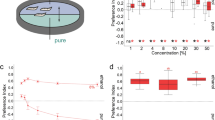Summary
Drosophila melanogaster can be conditioned to avoid an odorant selectively after being shocked in its presence (Quinn et al., 1974). In the following study learning and memory properties of the flies are reported. The major part of the conditioned behavior is acquired after a single training trial (Fig. 2). Similar degrees of learning are obtained by using various odorants in various combinations (Table 1). The flies can learn to avoid selectively several odorants at a time, can learn to discriminate between different concentrations of the same odorant (Fig. 4), and can also learn to distinguish a mixture of odorants from its components. If not extinguished, the selective avoidance decays slowly and can be detected for hours, its magnitude depending upon the intensity of training (Fig. 6). Memory can be disrupted by narcosis during the first ∼20 min after training, but not afterwards (Fig. 7). A study of learning properties of wild-type strains and various morphological and behavioral mutants reveals differences in performance (Table 2). However, the differences cannot be attributed with certainty to differences in learning and memory, per se, because the mutants differ in other aspects of behavior, e.g., locomotor activity and phototaxis. Of the wild-type strains tested, Canton-S performed the best.
Similar content being viewed by others
References
Bailey, N.T.J.: Statistical methods in biology. London: The English University Press 1968
Barondes, S.H.: Multiple steps in the biology of memory, pp. 272–278. In: The neurosciences: Second research program (F.O. Schmitt, ed.). New York: The Rockefeller University Press 1970
Barondes, S.H., Cohen, H.D.: Delayed and sustained effect of acetoxycycloheximide on memory in mice. Proc. nat. Acad. Sci. (Wash.)58, 157–164 (1967)
Barondes, S.H., Cohen, H.D.: Arousal and the conversion of “short-term” to “long-term” memory. Proc. nat. Acad. Sci. (Wash.)61, 923–929 (1968)
Benzer, S.: Behavioral mutants ofDrosophila isolated by countercurrent distribution. Proc. nat. Acad. Sci. (Wash.)58, 1112–1119 (1967)
Benzer, S.: Genetic dissection of behavior. Sci. Amer.229, 24–37 (1973)
Brown, J.A.: Some tests of the decay theory of immediate memory. Quart. J. exp. Psychol.10, 12–21 (1958)
Byers, D., Quinn, W.G.: Experiments on learning inDrosophila: effects of anesthesia and screening for learning mutants, p. 105. In: Caltech 1974 Biology Annual Report. Pasadena: California Institute of Technology 1974
Dethier, V.-G.: Insects and the concept of motivation, pp. 105–136. In: Nebraska Symposium on motivation, Vol. 14 (D. Levine, ed.). Lincoln: University of Nebraska Press 1966
Dingley, F., Maynard-Smith, J.: Temperature acclimatization in the absence of protein synthesis inDrosophila subobscura. J. Insect Physiol.14, 1185–1194 (1968)
Dudai, Y.: Molecular states of acetylcholinesterase fromDrosophila melanogaster. Dros. Inf. Serv.52, in press (1976)
Dudai, Y., Jan, Y.-N., Byers, D., Quinn, W.G., Benzer, S.:dunce, a mutant ofDrosophila deficient in learning. Proc. nat. Acad. Sci. (Wash.)73, 1684–1688 (1976)
Erber, J.: The dynamics of learning in the honey bee (Apis mellifica carnica): II. Principles of information processing. J. comp. Physiol.99, 243–255 (1975)
Gill, K.S.: A mutation causing abnormal mating behavior. Dros. Inf. Serv.38, 33 (1963)
Glassman, E.: The biochemistry of learning: an evaluation of the role of RNA and protein. Ann. Rev. Biochem.38, 605–646 (1969)
Hall, J.C., Kankel, D.R.: Gene controlling acetylcholinesterase inDrosophila melanogaster. Genetics83, 517–535 (1976)
Harris, W.A., Stark, W.S., Walker, J.A.: Genetic dissection of the photoreceptor system in the compound eye ofDrosophila melanogaster. J. Physiol. (Lond.)256, 415–439 (1976)
Hodgetts, R.B., Konopka, R.J.: Tyrosine and catecholamine metabolism in wild-typeDrosophila melanogaster and a mutant,ebony. J. Insect Physiol.19, 1211–1220 (1973)
Kaplan, W.D., Trout, W.E.: The behavior of four neurological mutants ofDrosophila. Genetics61, 299–309 (1969)
Kety, S.S.: The biogenic amines in the central nervous system: their possible roles in arousal, emotion and learning, pp. 324–336. In: The neurosciences. Second study program (F.O. Schmidt, ed.). New York: The Rockefeller University Press 1970
Konopka, R.J.: Abnormal concentrations of dopamine in aDrosophila mutant. Nature (Lond.)239, 281–282 (1972)
Lewis, E.B.: A new standard food medium. Dros. Inf. Serv.34, 117–119 (1960)
Lindsley, D.L., Grell, E.H.: Genetic variation ofDrosophila melanogaster. Carnegie Institution of Washington, Publ. No. 627, Washington, D.C. (1968)
Manning, A.: “Pre-imaginal conditioning” inDrosophila. Nature (Lond.)216, 338–340 (1967)
McGaugh, J.L., Herz, M.-J.: Memory consolidation. San Francisco: Albion Publishing 1972
Murphy, R.M.: Spatial discrimination performance ofDrosophila melanogaster: test-retest assessments and reinterpretation. Anim. Behav.21, 687–690 (1973)
Nelson, M.C.: Classical conditioning in the blowfly (Phormia regina): associative and excitatory factors. J. comp. physiol. Psychol.77, 353–368 (1971)
Quinn, W.G., Dudai, Y.: Memory phases inDrosophila. Nature (Lond.)262, 576–577 (1976)
Quinn, W.G., Harris, W.A., Benzer, S.: Conditioned behavior inDrosophila melanogaster. Proc. nat. Acad. Sci. (Wash.)71, 708–712 (1974)
Sparrow, J.C., Wright, T.R.F.: The selection for mutants inDrosophila melanogaster hypersensitive to a-methyl DOPA, a DOPA-decarboxylase inhibitor. Molec. gen. Genet.130, 127–141 (1974)
Spatz, H.Ch., Emanns, A., Reichert, H.: Associative learning ofDrosophila melanogaster. Nature (Lond.)248, 359–361 (1974)
Yetmann, F.R., Hirsch, J.: Attempted replication of, and selective breeding for, instrumental conditioning ofDrosophila melanogaster. Anim. Behav.19, 454–462 (1971)
Author information
Authors and Affiliations
Additional information
I thank Dr. S. Benzer for the hospitality of his laboratory, and S. Benzer, D. Byers, W. Harris, L. Jan, Y.-N. Jan, W. Quinn, D. Ready and M. Shankland for valuable discussions. This work was supported by an EMBO long-term fellowship and by a grant from the National Science Foundation to Dr. S. Benzer.
Rights and permissions
About this article
Cite this article
Dudai, Y. Properties of learning and memory inDrosophila melanogaster . J. Comp. Physiol. 114, 69–89 (1977). https://doi.org/10.1007/BF00656809
Received:
Issue Date:
DOI: https://doi.org/10.1007/BF00656809




